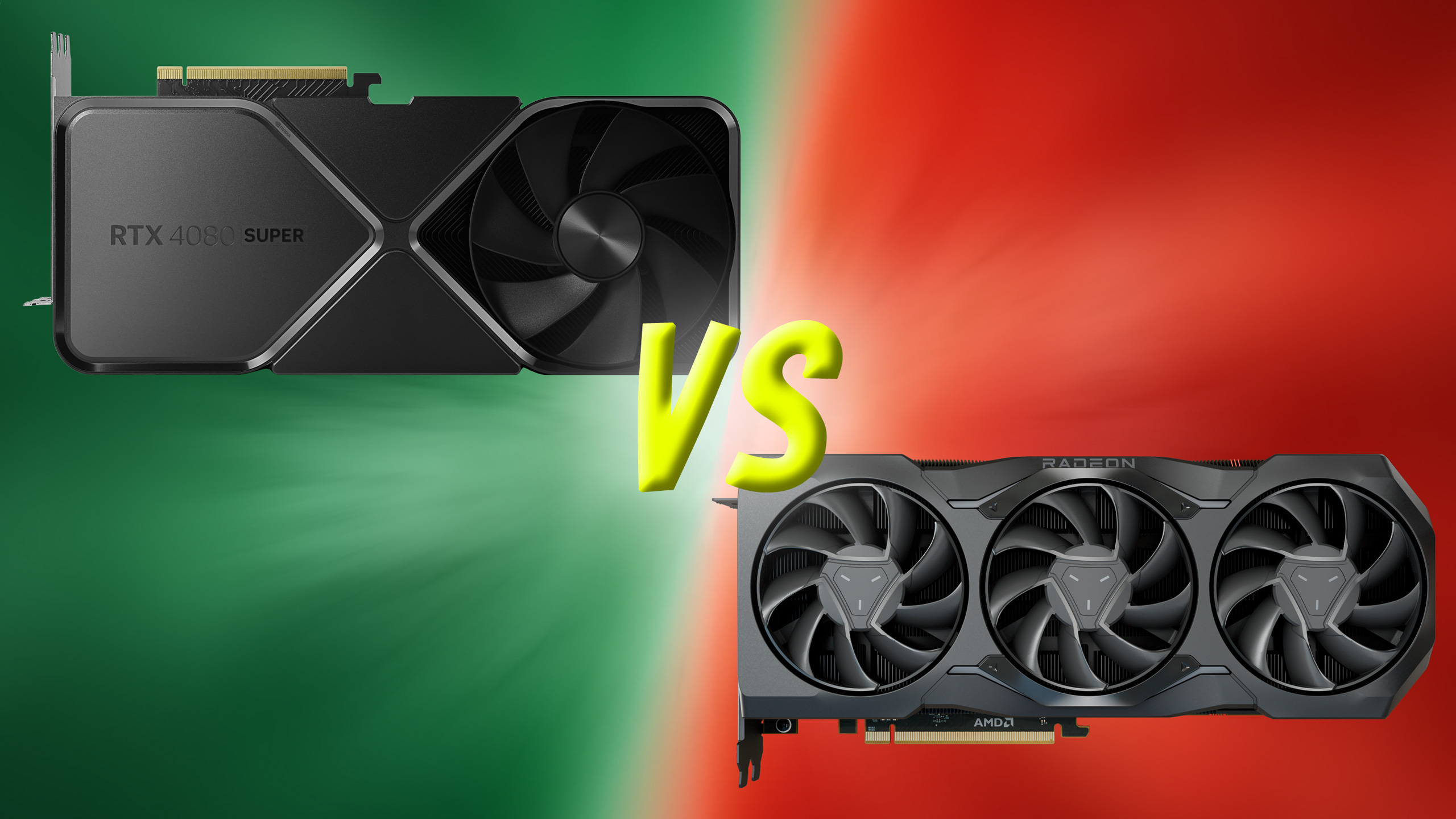
The RTX 4080 Super and RX 7900 XTX fill out the upper echelons of the gaming market, representing two of the best GPUs for Gaming you can buy. Nvidia has the even faster RTX 4090, but there's no direct AMD competitor for that extremely expensive card. If you don't have the deepest of pockets and are looking for a high-end GPU with at least a somewhat reasonable price point, the Nvidia RTX 4080 Super and AMD RX 7900 XTX are currently as good as it gets.
The RTX 4080 Super debuted earlier this year as a refreshed variant of the fast but ultimately overpriced RTX 4080. The RTX 4080 Super rectified the RTX 4080's pricing problem by dropping the MSRP $200, though it failed to provide any noteworthy performance improvements over the vanilla 4080. The card sits in a good position overall, thanks to the price cut, and it effectively replaces the original 4080 which is now being phased out — cards still exist, but without a price drop there's no reason to pick them up.
The RX 7900 XTX remains AMD's flagship GPU, now coming up on two years old. There are rumors that AMD originally wanted to make a RTX 4090 competitor, but it underestimated just how potent and large Nvidia's AD102 die was going to be. AMD ditched any hope of claiming the overall performance crown, opting instead to compete with Nvidia's penultimate GPU. It also undercut the RTX 4080 by $200, but now officially it has the same $999 MSRP as the 4080 Super.
How do the RX 7900 XTX and RTX 4080 Super stack up in today's market? We'll discuss the strengths and weaknesses of both GPUs to declare a victor, as we check out the performance, pricing, features, technology, software, and power efficiency — listed in order of generally decreasing importance.
RTX 4080 Super vs RX 7900 XTX: Performance
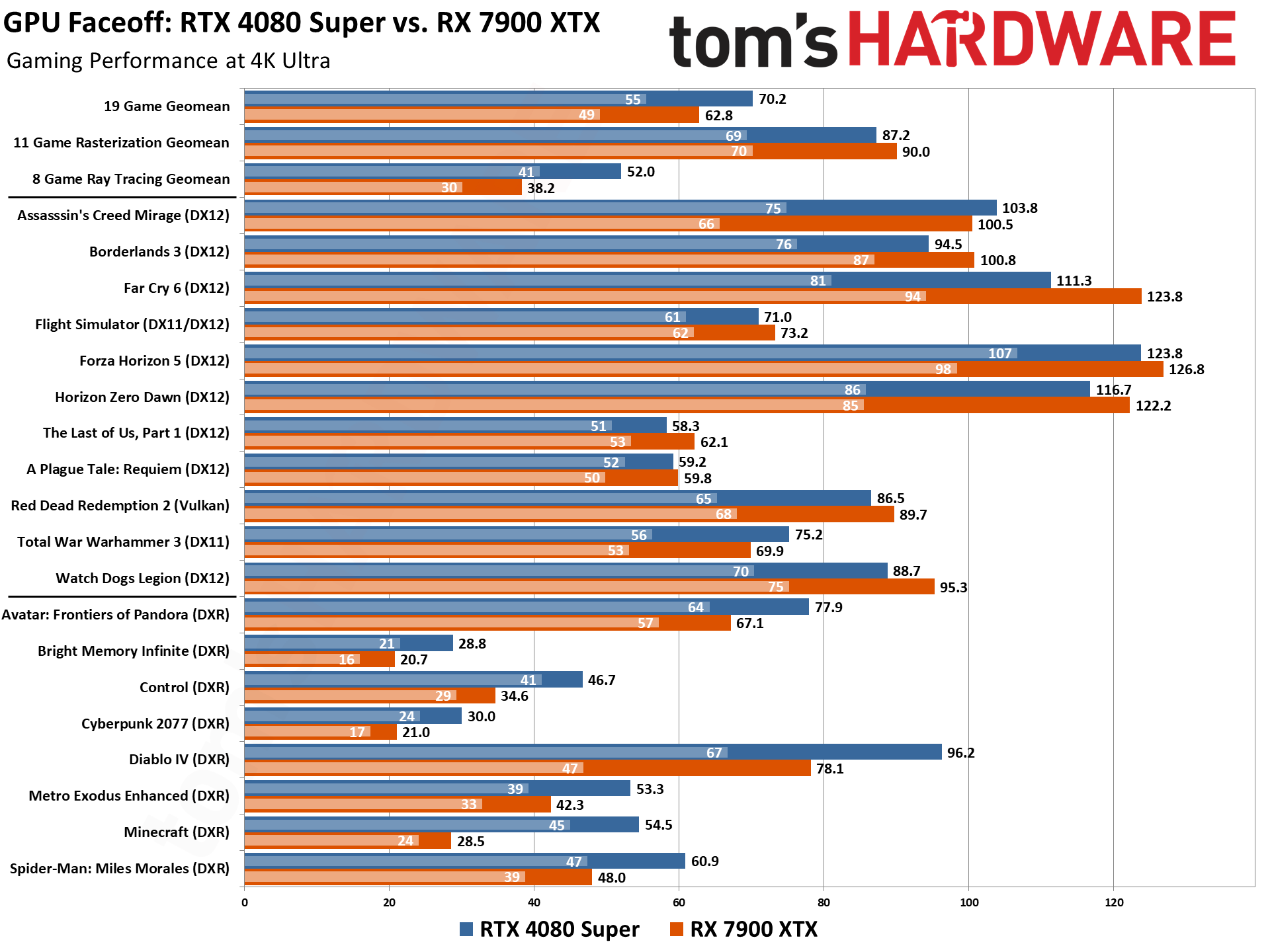
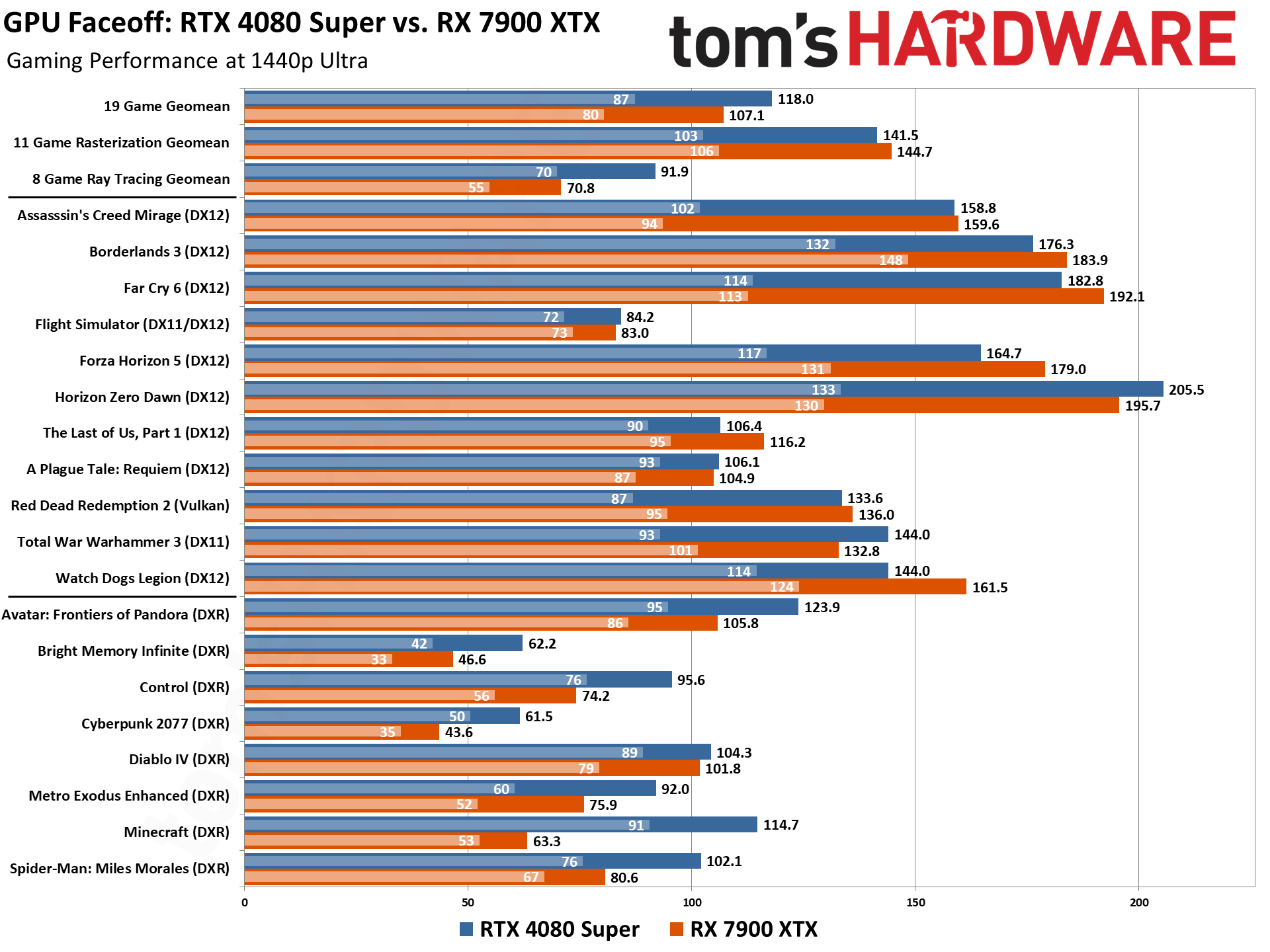
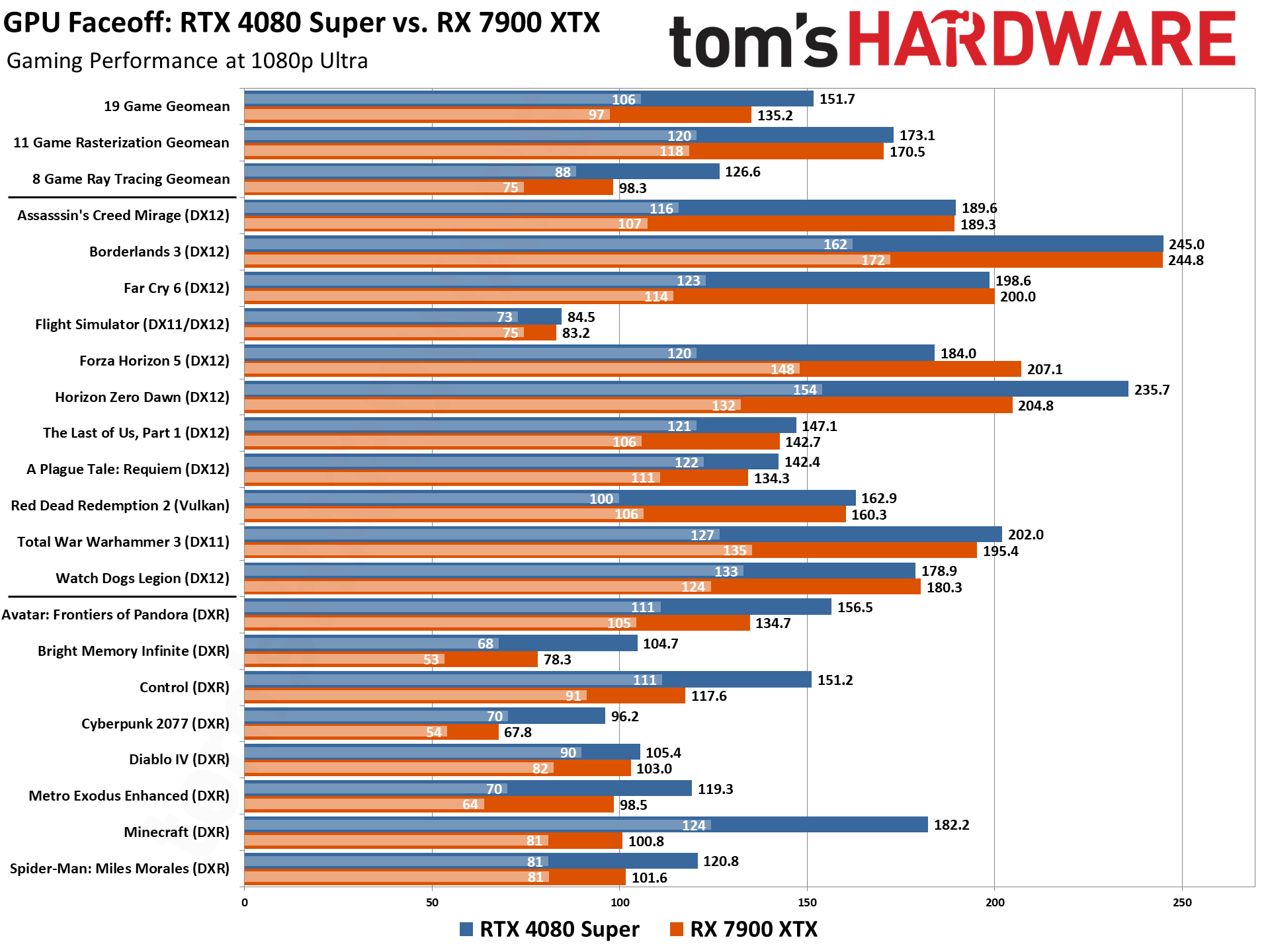
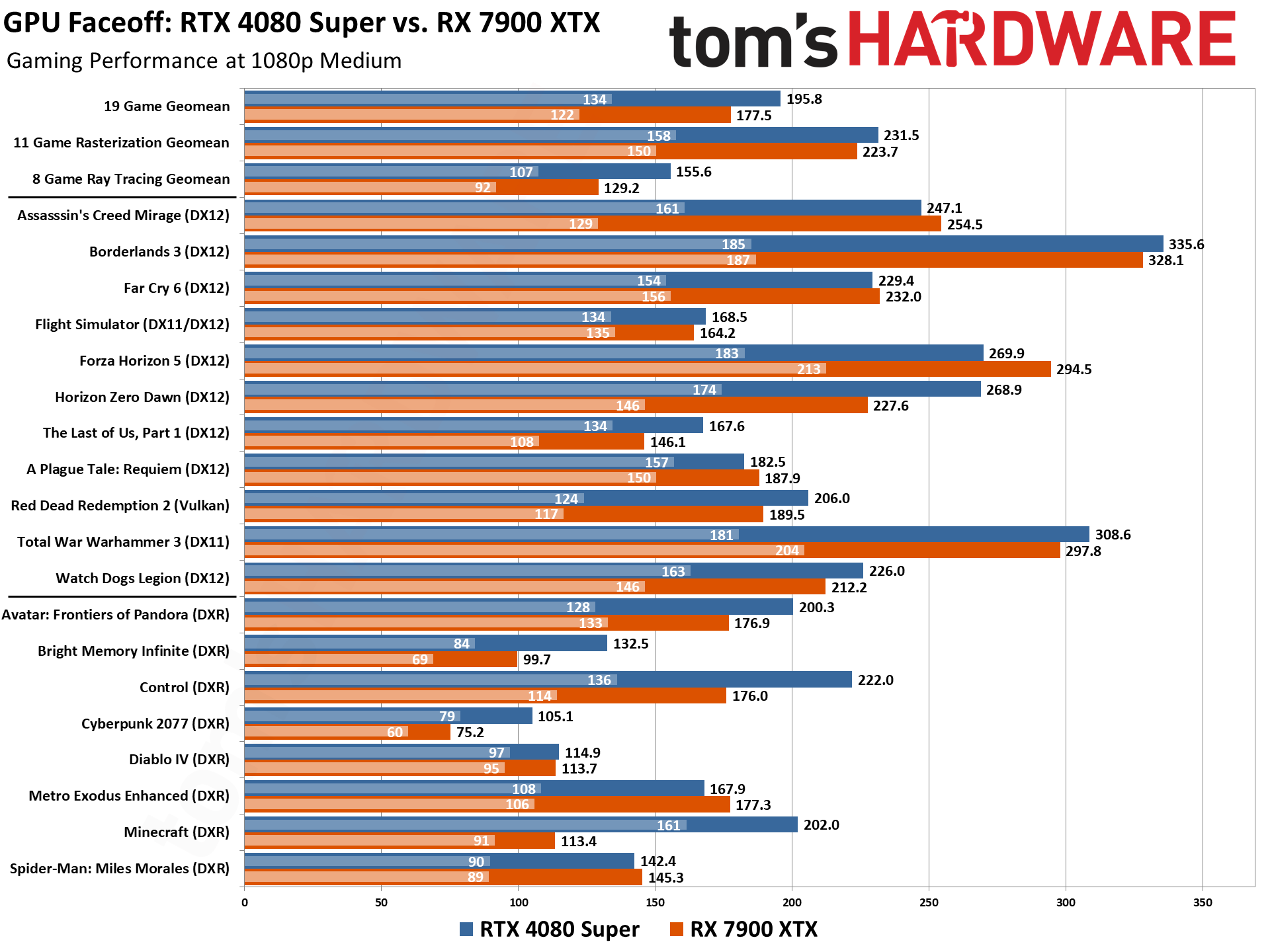
The RTX 4080 Super and RX 7900 XTX offer superb gaming performance at the three most common resolutions — 4K, 1440, and 1080p. Since these are two of the fastest and most expensive graphics cards at present, they're most likely to be used for 4K or 1440p gaming (including ultrawide 3440x1440, though we don't test that in-between resolution). Overall performance is very strong for both GPUs, offering triple digit frame rates in the vast majority of our testing suite at 1440p and 1080p. 4k performance is also good, offering a 60 FPS or better experience in most titles.
Where the two GPUs differ significantly is in ray tracing performance. The RTX 4080 Super offers a substantial performance benefit, beating the RX 7900 XTX by 28–36 percent across the three resolutions — 1080p medium scores are closer, but then these GPUs really aren't intended for such undemanding settings. The more intensive the ray-tracing graphics are, the wider the gap between the Nvidia GPU and its AMD counterpart.
This is especially apparent in Minecraft with full path tracing, where the RTX 4080 Super offers 80–90 percent higher performance. It also leads by around 40% in Cyberpunk 2077, 35% in Bright Memory: Infinite, 30% in Control, and by 27% in Spider-Man: Miles Morales at 1440p and 4K. It's only in less demanding ray tracing games like Diablo IV, Avatar, and Metro Exodus where the 7900 XTX even comes close to the 4080 Super — and Diablo IV (with RT enabled) ends up being severely CPU limited.
This isn't surprising at all. Nvidia's ray-tracing hardware has been superior to AMD's counterparts since the very beginning — AMD didn't offer RT support in 2018, and it continues to relegate the feature to second-class status. It's still playing catch-up in the ray tracing department, seemingly content to argue that ray tracing remains a non-critical feature for modern gaming GPUs.
Conversely, the RX 7900 XTX does much better in high-resolution rasterization-only performance. While 1080p still slightly favors the 4080 Super, the RX 7900 XTX takes an overall slight lead in our rasterization test suite at 1440p and 4K — again, where it matters most on high-end GPUs that cost close to a grand. The 7900 XTX and 4080 Super are mostly on par, with a few games that more heavily favor one or the other card. Focusing mostly on the 1440p and 4K results, AMD pulls ahead in by more than a few percent in Forza Horizon 5, Far Cry 6, and Watch Dogs Legion. The 4080 Super still leads in Total War: Warhammer 3, with most of the other games ending up basically tied (within 5% of each other).
The reality for gaming is that there aren't really any pure rasterization games where either the 7900 XTX or 4080 Super holds a significant advantage, particularly at higher resolutions and settings. There are two instances in our tests suite (out of 22 tests at 1440p and 4K) where the 7900 XTX leads by 10% or more: Far Cry 6 and Watch Dogs Legion, both at 1440p. In that sense, the cards are basically tied for rasterization performance, and the overall results range from a +3% lead for the 4080 Super at 1080p to a +3% lead for the 7900 XTX at 4K — measurable, but not particularly significant.
Which means the ray tracing results hold more sway, and the approximately 30% higher performance offered by the 4080 Super isn't just a meaningless lead. We think people buy high-end cards to be able to crank up all the settings, and there are RT-enabled games where the 4080 Super delivers a playable result while the 7900 XTX does not.
And there's also the upscaling aspect to consider. DLSS and FSR have been used in hundreds of games, but there are still more that use DLSS. DLSS also continues to offer superior upscaling image quality, so it's even more of an advantage. When rasterization performance is more or less equivalent, other elements take the foreground.
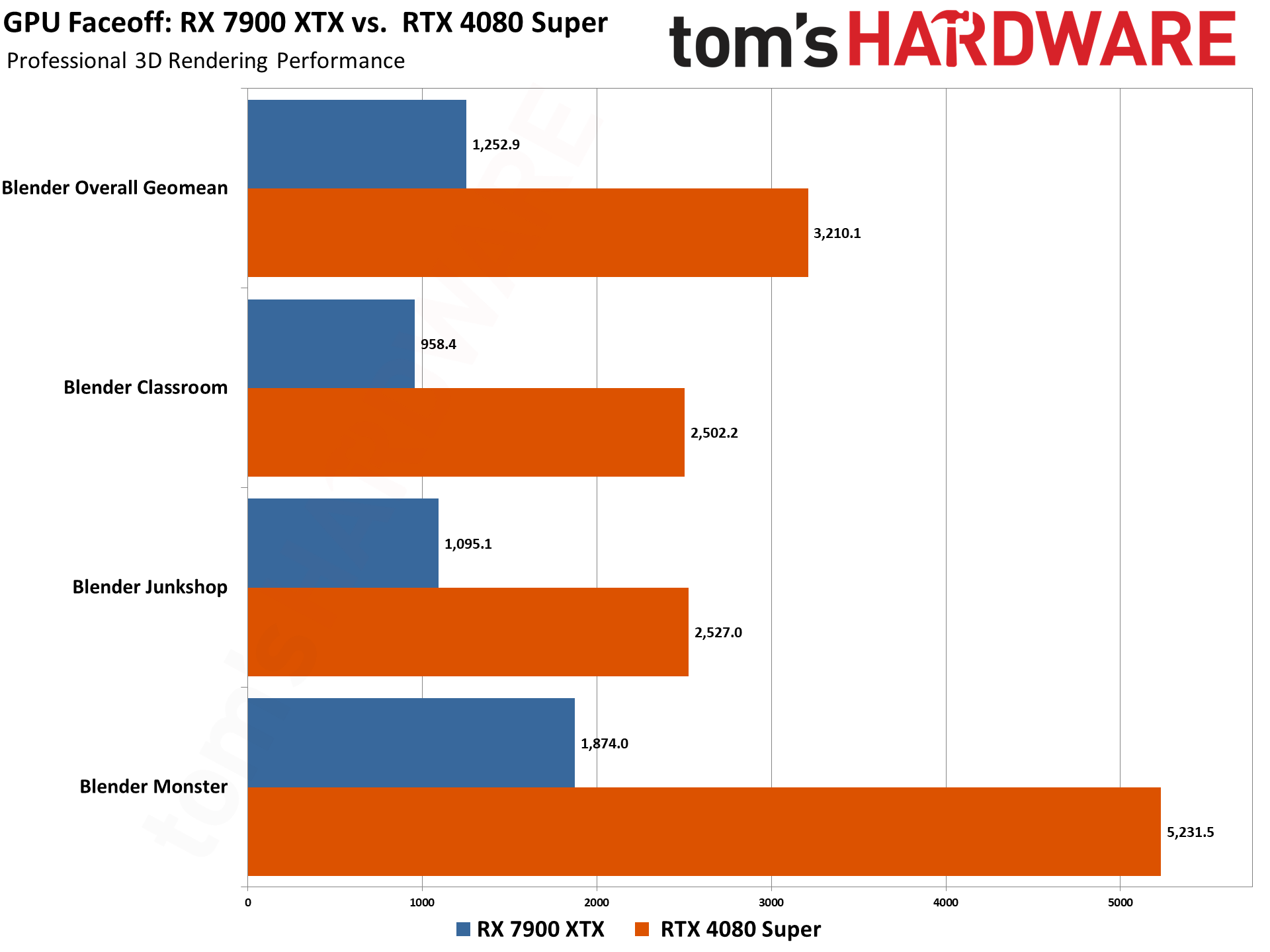
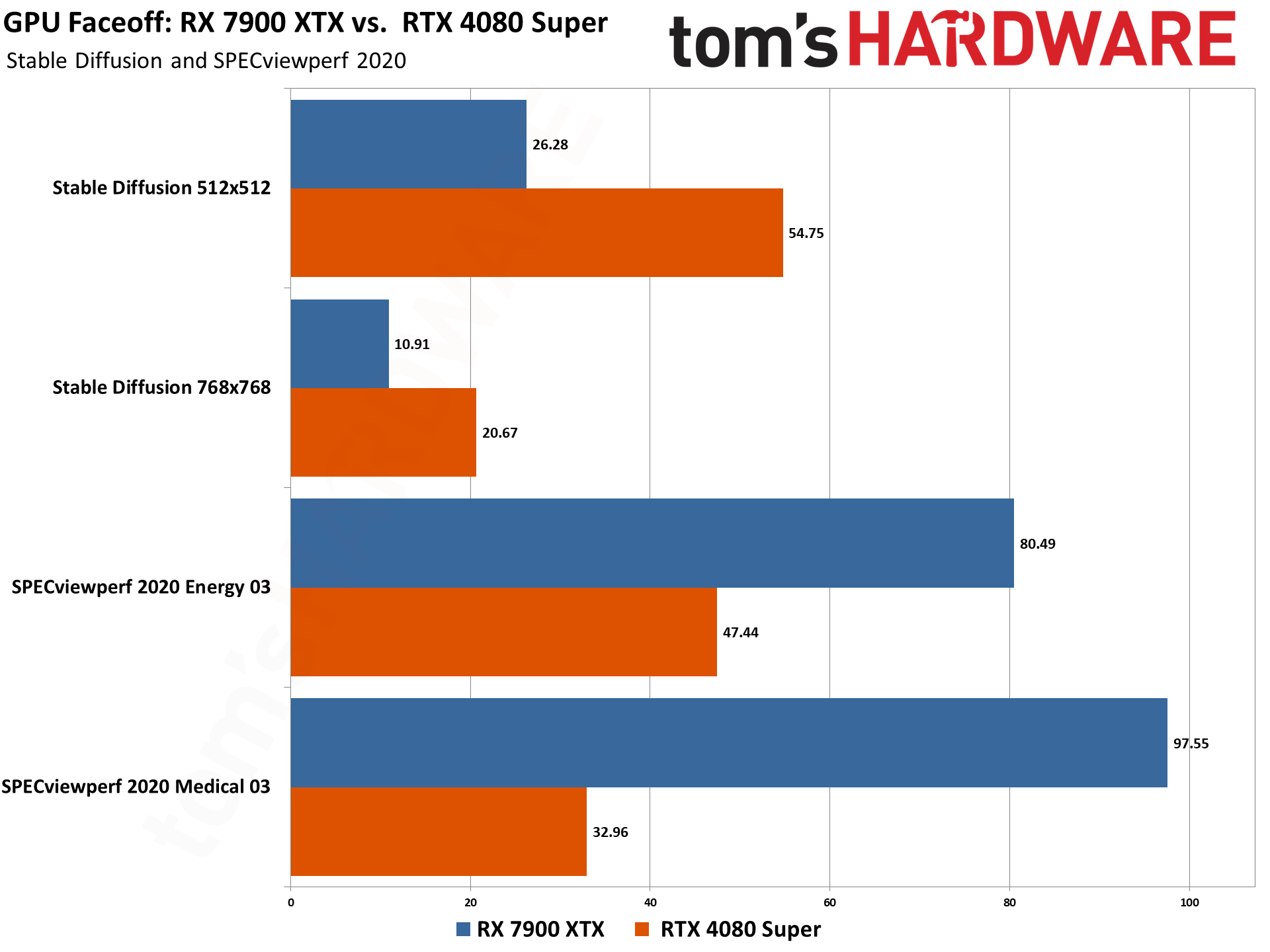
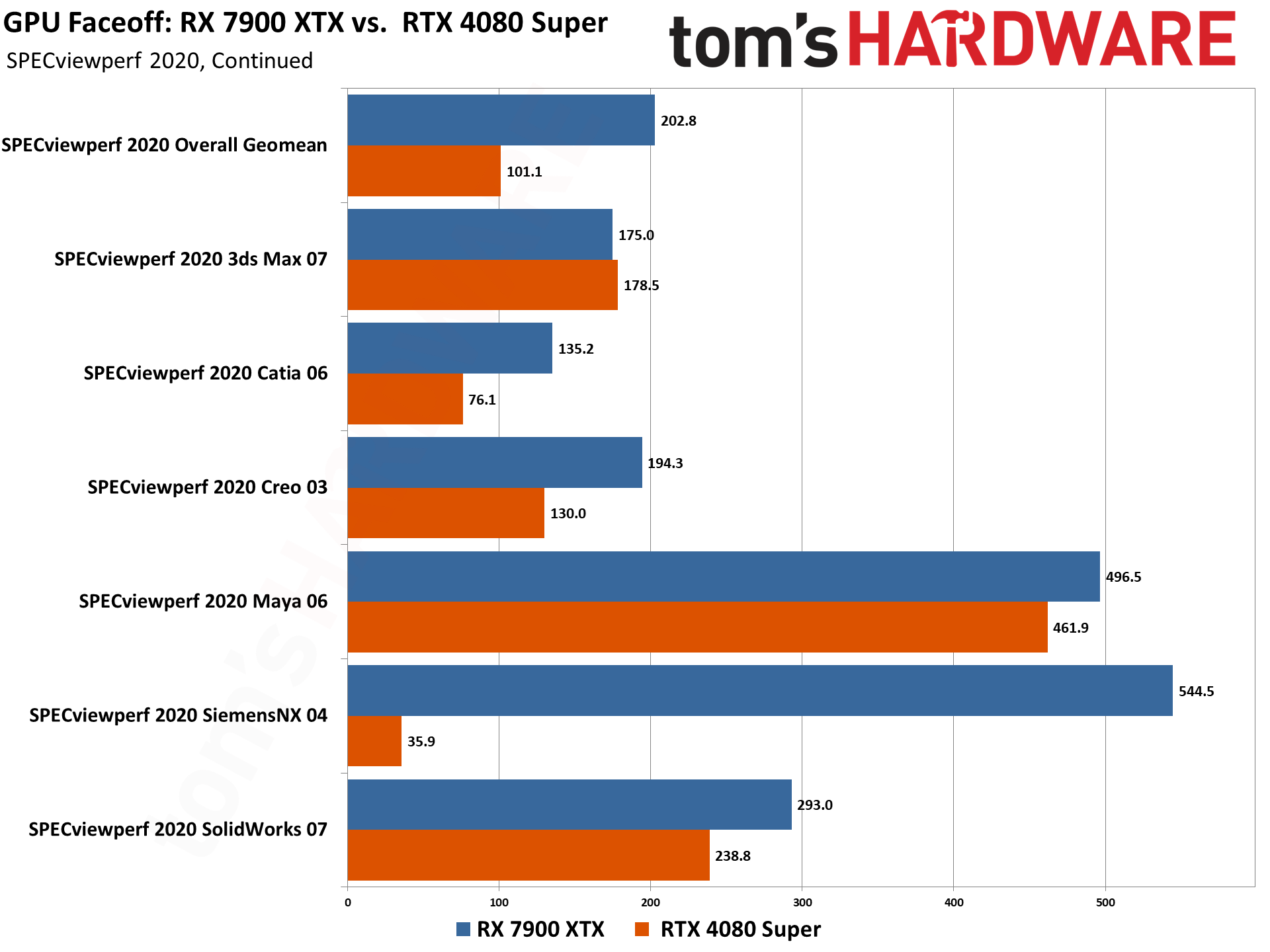
The professional and AI workloads tend to end up heavily favoring either Nvidia or AMD. Blender and Stable Diffusion testing give the RTX 4080 Super a massive lead of 89% (Stable Diffusion 768x768) to 156% (Blender). AMD does much better in SPECviewperf 2020, however, with double the performance in our (not official) aggregate score.
If you're planning on using a consumer GPU for any of these professional workloads, In professional workloads, factor in these results as appropriate. We feel the AI results are arguably the biggest factor, since that's becoming an increasingly relevant use case even on consumer hardware. But if you happen to use Siemens NX, the 7900 XT boasts a whopping 14X performance advantage over the 4080 Super.
Overall Performance Winner: Nvidia RTX 4080 Super
Overall, we give the RTX 4080 Super the win here. Even though the RX 7900 XTX comes out slightly ahead of the RTX 4080 Super in rasterization performance, it's almost never by a sizeable margin. In contrast, the RTX 4080 Super dwarfs the RX 7900 XTX in ray-tracing performance, and DLSS and AI workloads widen the gap. There are use cases where the 7900 XTX would be the better choice, but for gaming Nvidia gets the win.
RTX 4080 Super vs RX 7900 XTX: Price
The official MSRP prices for the RTX 4080 Super and RX 7900 XTX are the same $999. Retail pricing tells a slightly different story, however. At the time of writing, the RX 7900 XTX is the price leader.
The lowest-priced 7900 XTX we could find is the ASRock Phantom Gaming OC for $899 at Newegg. That's $100 below the official MSRP. Several other models cost closer to $900 as well, like the XFX Speedster Merc 310 for $915 at Amazon and the Sapphire Pulse for $899 at Newegg (after a $30 instant rebate). Most RX 7900 XTX cards currently cost anywhere between $900 and $1,030.
The lowest-priced RTX 4080 Super we could find is the PNY Verto OC for $976 at Amazon, or $969 at Newegg (after a $20 instant rebate). Most other cards cost over $1,000, with some landing closer to the old $1,200 price point that the vanilla RTX 4080 occupied. There's also the RTX 4080 Super Founders Edition at Best Buy for $999, though it's currently "Unavailable nearby" for us; YMMV.
Price Winner: AMD RX 7900 XTX
While a $100 price difference isn't massive when we're talking about graphics cards that cost around $1,000 (give or take), AMD wins the pricing comparison for most "roughly equivalent" models. Meaning, if you look at a heavily overclocked model with lots of RGB and other extras, the 7900 XTX will end up being less expensive than the 4080 Super. Bear in mind that if you factor in performance (FPS/$), using our full test suite, Nvidia does take a slight lead.
RTX 4080 Super vs RX 7900 XTX: Features, Technology, and Software
The RTX 4080 Super and RX 7900 XTX take very different approaches to GPU architectures. Besides the difference in ray tracing and AI capabilities, the raw specs are also quite different.
Nvidia gives the 4080 Super 10,240 GPU shader cores for example, while AMD's RX 7900 XTX has just 6,144 shader cores. However, the AMD shaders have double the FP32 compute and so overall you get a theoretical 61.4 teraflops from AMD versus 52.2 teraflops from Nvidia. But that's more theoretical than practical, so look at the performance testing above to see how they stack up.
Elsewhere, the RTX 4080 Super has a unified die that utilizes TSMC's 4N node (roughly 5nm-class, tuned for Nvidia). The RX 7900 XTX uses a more complex multi-chiplet design with TSMC's N5 used on the GCD (Graphics Compute Die) and N6 for the MCDs (Memory Cache Dies). All indications are the AMD's use of GPU chiplets was primarily for cost reduction purposes, and it can actually hurt performance compared to a unified die.
That ties into the memory configurations, which are quite different. The RX 7900 XTX throws in a beefy 384-bit wide memory interface in combination with a very healthy 24GB of VRAM. With memory clocked at 20 Gbps, that yields 960 GB/s of raw memory bandwidth. Then there's an additional 96MB of L3 Infinity Cache to boost effective bandwidth. Nvidia by comparison only has a 256-bit interface and 16GB of memory, with superior memory compression and cache performance making up the difference. With 23 Gbps GDDR6X, the 4080 Super has 736 GB/s of raw bandwidth, and 64MB of L2 cache.
On paper, AMD's memory subsystem seems like it should be far superior to Nvidia's memory configuration. 50% more memory, 50% more cache, and 30% more raw bandwidth. In practice, however, Nvidia generally matches the AMD card on performance, as shown earlier. Both approaches are valid, just with different tradeoffs involved.
As shown and discussed already, there are clear differences in the underlying architectures, particularly when it comes to ray tracing and AI workloads. Nvidia's Ada Lovelace GPU architecture has dedicated silicon for both workloads, sporting third generation RT cores and fourth generation tensor cores for accelerating AI work. AMD has second generation RT accelerators and first generation AI accelerator support, but both appear far less performant than Nvidia's offerings.
Look at the RTX 4080 Super's raw computing specs, which dwarf the RX 7900 XTX in FP16 — 418 teraflops to 123 teraflops. The RTX 4080 Super also has native FP8 support, with double the compute rate (836 teraflops) of FP16. Both FP16 and FP8 are critical elements of AI workloads. Note that the Nvidia numbers offer sparsity, though even at half the stated values it's still a clear win for the 4080 Super.
AMD's RX 7900 XTX counters with substantially more ROPS (Render Outputs), which contributes to the GPU's superior rasterization performance. Breaking the GPU into multiple chiplets also makes the design very different from Nvidia's approach. Long-term, all GPUs will likely trend toward using chiplets in various forms, but for now AMD is the only company doing it on consumer GPUs.
Moving away from the hardware specs, Nvidia and AMD have competing software and driver features. One of the most important features is the upscaling solutions: DLSS (2/3) and FSR (2/3), respectively. DLSS generally delivers superior image quality, while AMD’s FSR has the advantage of being able to work on any GPU — not just AMD hardware. Both companies also offer frame generation technology, but Nvidia accomplishes this in hardware via its Optical Flow Accelerator while AMD does all the computations on shaders. It's great that we have the choice between these features, but that doesn't change the fact that Nvidia still holds the quality and adoption rate advantage.
In terms of drivers, Nvidia and AMD are relatively equal, with both routinely providing "game ready" drivers for major game launches. Nvidia does have more driver-tangential software solutions than AMD, however, particularly ones that are AI-focused. These include Broadcast, ChatRTX, Reflex, and Video Super Resolution, and these tend to work well and integrate better than AMD's alternatives (where such things exist).
Features, Technology, and Software Winner: Nvidia RTX 4080 Super
AMD has plenty to offer with the RX 7900 XTX, particularly if you only care about traditional rasterization games. However, GPUs and graphics cards are becoming increasingly important for a wider range of tasks, and AI in particular could radically alter the way we use our PCs in the future. Or not. But even now, the combination of hardware features and software solutions gives the Nvidia RTX 4080 Super the overall win in this category.
RTX 4080 Super vs RX 7900 XTX: Power Efficiency
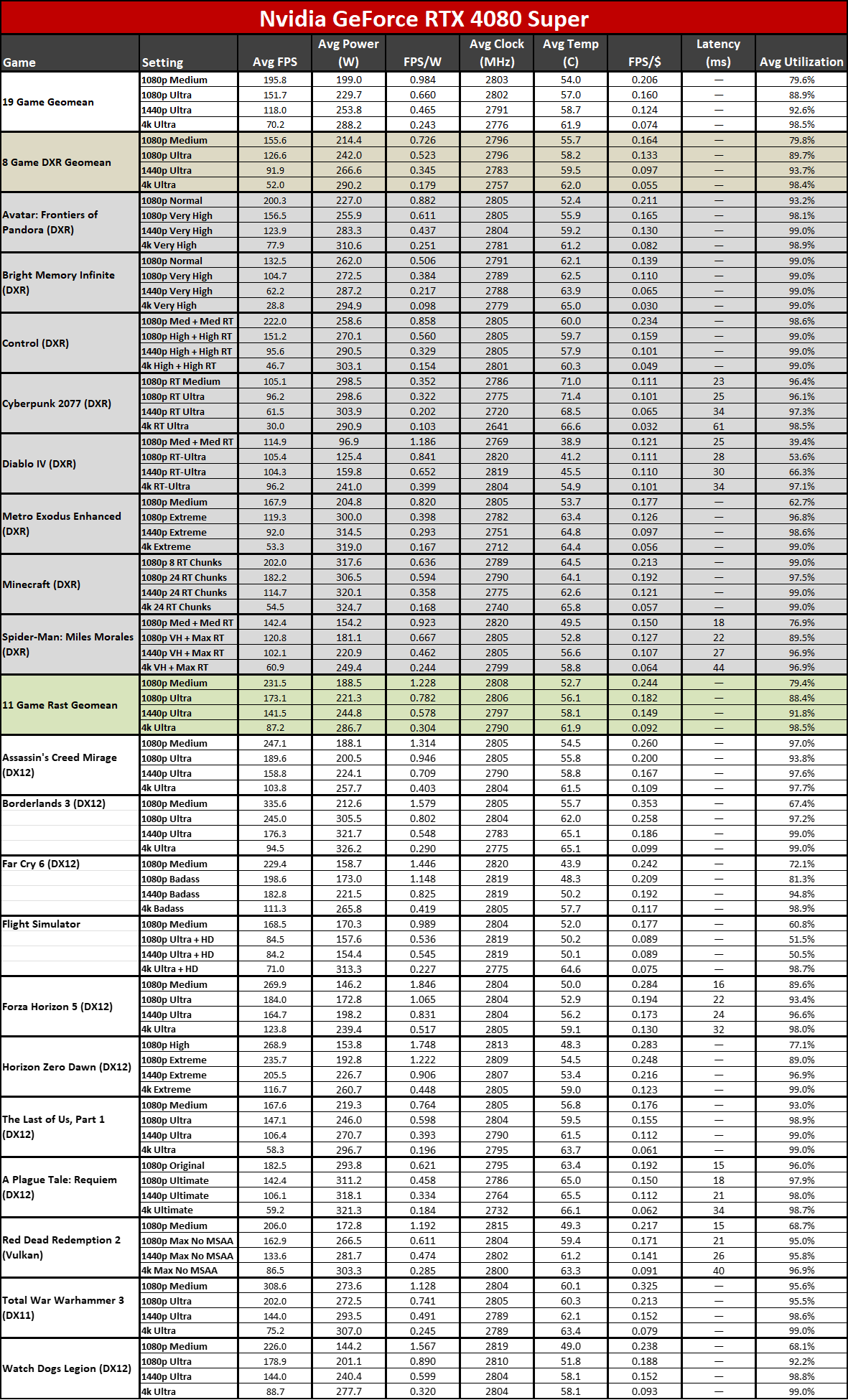
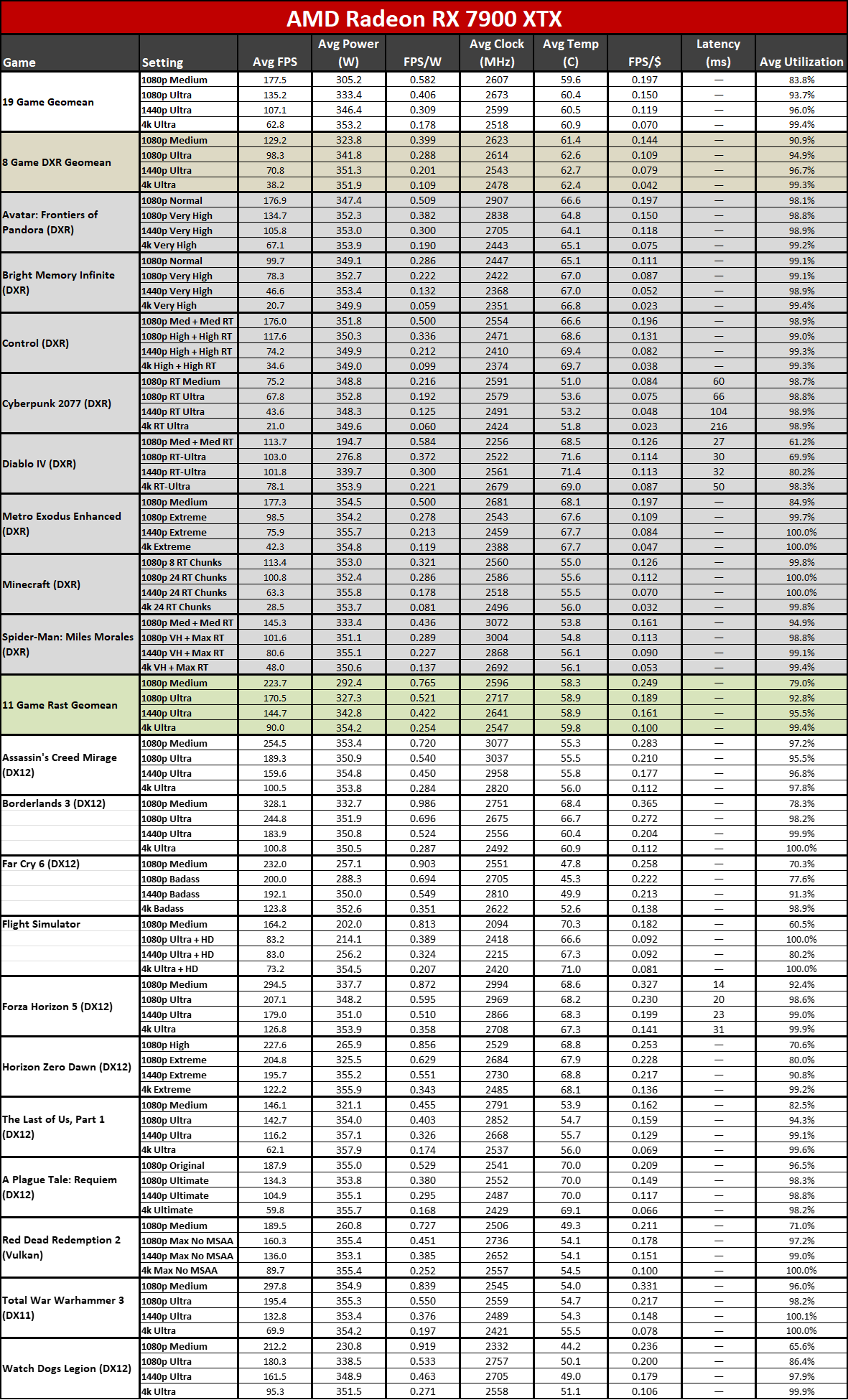
If you've seen any of our other GPU faceoffs lately, it should be no surprise that power use and efficiency massively favor the RTX 4080 Super. Across our full test suite, which encompasses 76 different tests at four resolution/setting combinations, the RTX 4080 Super at times used as much as 106W less power than the RX 7900 XTX (that's at 1080p medium).
In general, even at 1440p and 4K, the 4080 Super ends up being far more efficient than the 7900 XTX: It used on average 92W less power at 1440p, and 65W less power at 4K. (Note that the lower power use at 1080p is mostly because CPU and other system bottlenecks prevent the GPUs from reaching their full potential.)
One of the interesting aspects of power use is that the RX 7900 XTX tends to be more consistent at hitting close to its rated TBP (Total Board Power), with only a modest dip at 1080p medium settings. It pulled 305W on average at 1080p medium, and 333W at 1080p ultra — 86% and 94% of its rated 355W TBP. The 4080 Super by contrast does much better at trimming power use under lighter loads, drawing just 199W at 1080p medium and 230W at 1080p ultra — 62% and 72% of its rated 320W TGP (Total Graphics Power).
It's not just about power while gaming, either. We've done some testing of idle and light workload power draw as well. The 4080 Super used just 16.5W while idle, 20.8W while playing back a 4K AV1 video using VLC, and 31.0W when playing the same video directly on YouTube. The 7900 XTX used 19.1W while idle, 57.8W while playing our test video in VLC, and 96.8W when viewing the video on YouTube.
Some of the power efficiency advantage for the 4080 Super comes from the TSMC 4N process technology, but a lot of it just appears to be thanks to superior firmware and driver tuning. AMD's 7900 XTX has actually gotten quite a bit better since it first came out — it used to routinely idle at 90W! — but there's still plenty of room for improvement.
Power Efficiency Winner: Nvidia RTX 4080 Super
In terms of performance per watt, across our test suite the 4080 Super beats the 7900 XTX 63% at 1080p ultra, 50% at 1440p ultra, and 37% at 4K ultra. While the energy savings aren't likely to be a deciding factor for anyone in the market for a $1,000 graphics card — even running 24/7, a ~75W difference would only amount to $65 (for 10 cents per kWh), and most people won't run their GPU flat out for more than perhaps four hours per day. But more power means more heat, more fan noise, and potentially the need for a larger PSU.
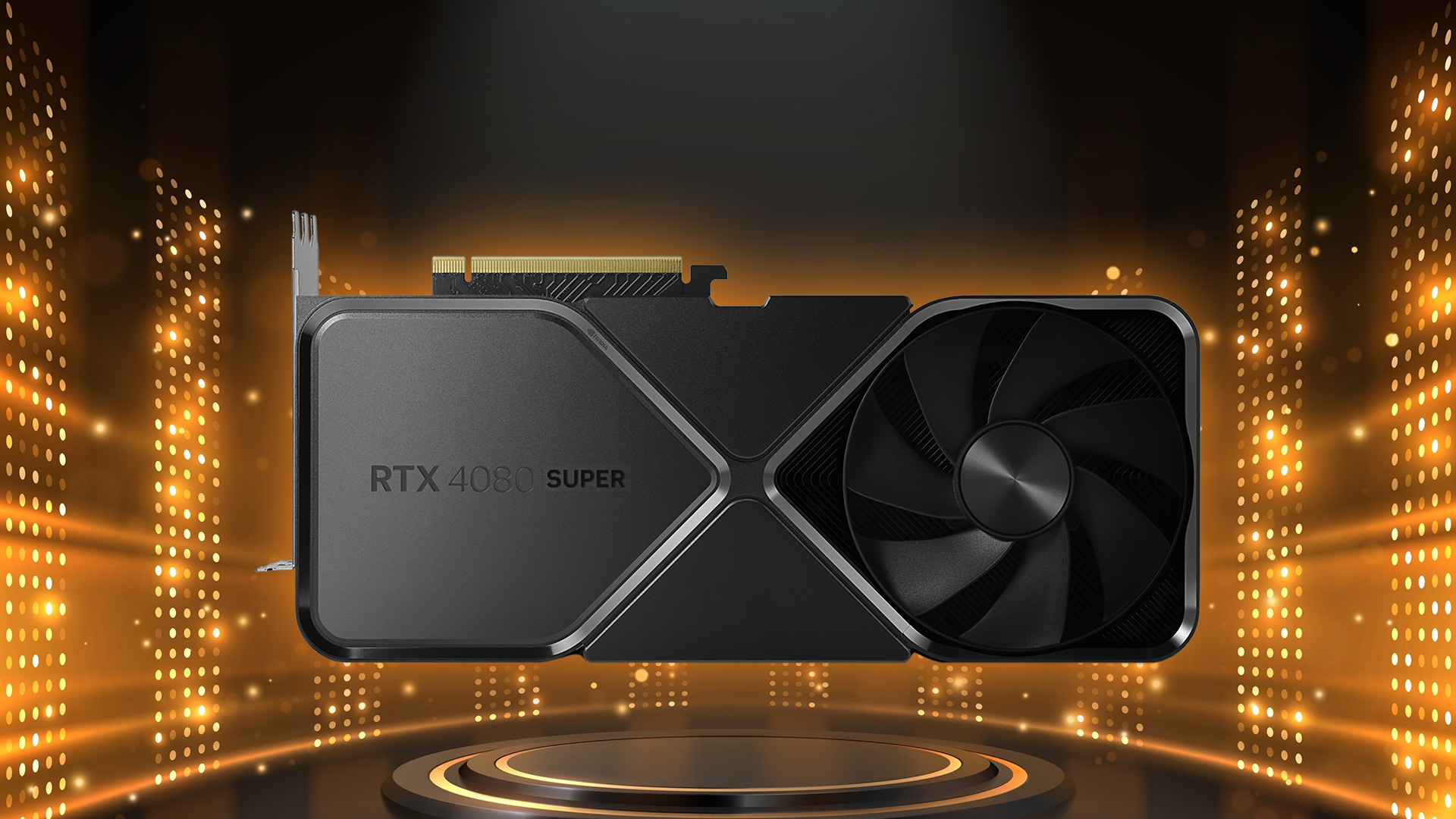
RTX 4080 Super vs RX 7900 XTX Verdict
Both the RTX 4080 Super and RX 7900 XTX are good cards, but the 4080 Super is simply the better card of the two when we look at the big picture. The RX 7900 XTX put up a much better fight against the vanilla RTX 4080 thanks to Nvidia's sky-high $1,200 MSRP, making the 7900 XTX the much more affordable option. Now, however, Nvidia has come back swinging with the RTX 4080 Super, strategically priced the same as the 7900 XTX — which is why street prices have dropped a bit on the AMD cards.
The RTX 4080 Super wins on performance, particularly if you do anything with AI or ray tracing. AMD has a very slight edge in rasterization performance, but even that's not significant enough to really matter. AMD does have a raw VRAM capacity advantage, but the biggest use case for more VRAM — running AI large language models — heavily favors Nvidia GPUs on performance, making it a questionable advantage to be able to run certain workloads at roughly half the speed of Nvidia's GPU. Hardware and software features, plus power efficiency, are also stronger on the RTX 4080 Super.
An official price drop on the 7900 XTX would help AMD, but we're already getting close to the launch of the next-generation GPUs. Nvidia Blackwell RTX 50-series GPUs are expected this fall, and AMD may not even make high-end RDNA 4 GPUs. We can only imagine that AMD will need to cut the 7900 XTX once the 5090/5080 come out, if it doesn't have a newer alternative, and even now we're not sure why the 7900 XTX hasn't received a price cut already. AMD cut the price of the RX 7900 XT significantly since launch, with an official $749 MSRP now ($200 less than the launch MSRP). The 7900 XTX really needs to follow suit.
As it stands now, the RTX 4080 Super is the card to beat in the ultra high-end space — not counting the RTX 4090. It's the winner of this GPU faceoff and will appeal to anyone who wants one of the fastest graphics cards around. The biggest concern at this point is the pending announcement of future GPUs that will presumably be even faster, though who knows how much those will cost.







